Shopify Schema Markup: How to Implement Structured Data?

Schema markup might sound technical, but it’s actually one of the most effective -and overlooked- ways to boost your Shopify store’s visibility in Google. Think of it as adding a special “label” to your website’s content that tells search engines exactly what your pages are about. This extra layer of clarity helps Google show richer, more detailed search results -like product prices, ratings, availability, and breadcrumbs- directly under your listings.
And here’s the good news: you don’t need to pay for expensive Shopify apps or hire a developer to make it happen. Many store owners assume structured data is complicated or requires coding knowledge. The reality? With the right guide, you can implement schema markup yourself by simply copying and pasting a few snippets into your theme.
In fact, adding schema isn’t just about showing up in search results it’s about standing out. By enabling rich snippets, your products grab more attention, attract more clicks, and build credibility with both Google and shoppers. Schema markup also plays a critical role in long-term SEO strategy, giving your store a competitive edge in crowded search results.
In this guide, we’ll walk you through everything you need to know about adding schema markup to your Shopify store from what it is, to which types you need, to exactly where and how to add it. You’ll learn how to boost your search visibility, earn trust, and showcase your products in the best possible light without spending a dime on apps or outside help.
Ready to take control of your SEO? Let’s get started.
What is Structured Data?
Structured data is a standardized format for providing information about a page and classifying its content. In the context of e-commerce, it helps search engines understand product details, reviews, pricing, and more, enabling them to display rich snippets in search results.
How Schema Appears
When implemented correctly, schema markup can result in rich snippets—enhanced search listings that display additional information such as product ratings, prices, and availability. These snippets make your listings more attractive and informative, potentially increasing click-through rates.
Subscribe to our mailing list to get the new updates!
Rich Snippets
Rich snippets are the visible result of structured data. For e-commerce sites, they can include:
- Product name
- Price
- Availability
- Star ratings
- Review count
By providing this information directly in search results, rich snippets can enhance user engagement and drive more traffic to your store.
How Schema Builds Authority with Google
Implementing schema markup signals to Google that your site provides valuable and structured information. This can improve your site’s credibility and authority, leading to better rankings and increased trust from users.
How to Build Structured Data
Let’s start boosting your Shopify store’s visibility.
#1. Corporation Schema Markup:
First go to your “Online Store > Themes” and click on “Edit code”.
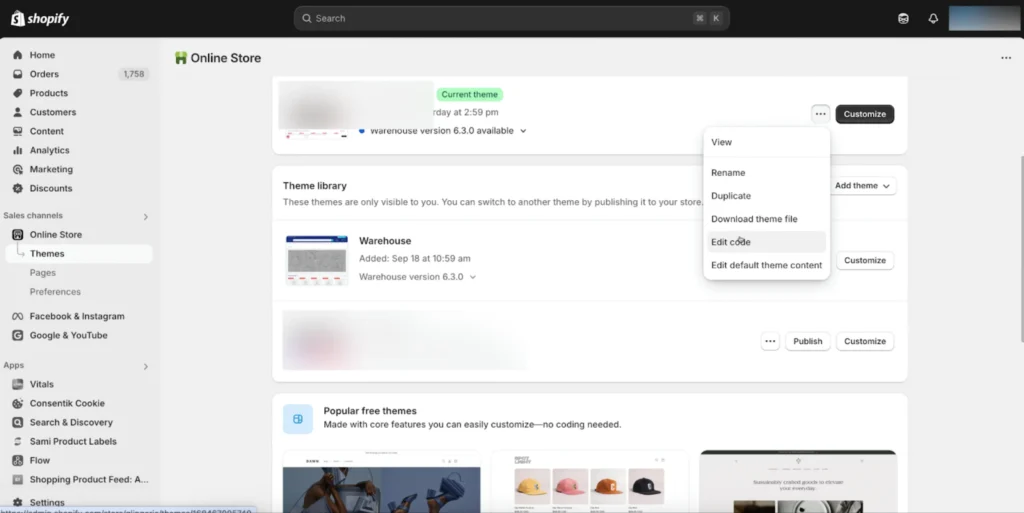
And then create a new snippet file called “corporation-schema.liquid” and paste our corporation schema code:
https://github.com/mehmetsanli/schema-markup/blob/main/corporation-schema-markup
(Don’t hesitate to remove unnecessary parts if you don’t want to use.)
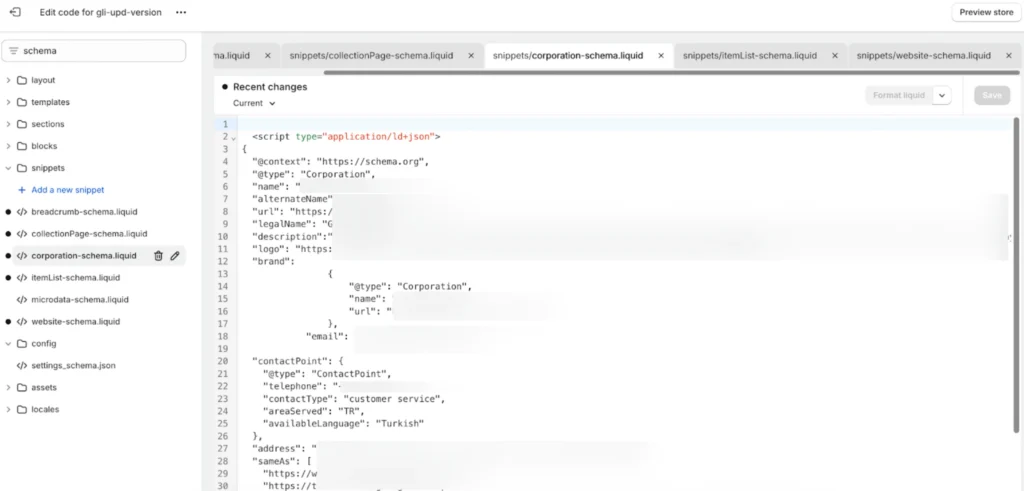
In the last step, you just need to call/render your corporation schema markup code on your store. Please keep in mind that I always call organization and website schema on just corporate pages like homepage, about, and contact. If you want to do like this, just add this code in your theme.liquid file:
{% if template == 'index' or template == 'page' or template == 'contact' %}
{% render 'corporation-schema' %}
{% render 'website-schema' %}
{% endif %}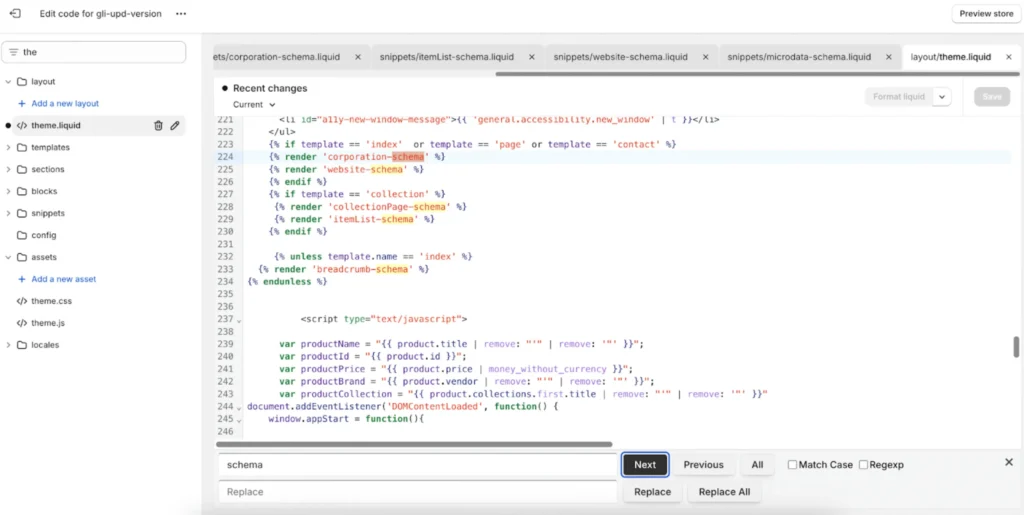
Congrats! Your schema markup is ready. Use this tool to check if it is working properly:
#2. Website Schema Markup:
First go to your “Online Store > Themes” and click on “Edit code”.
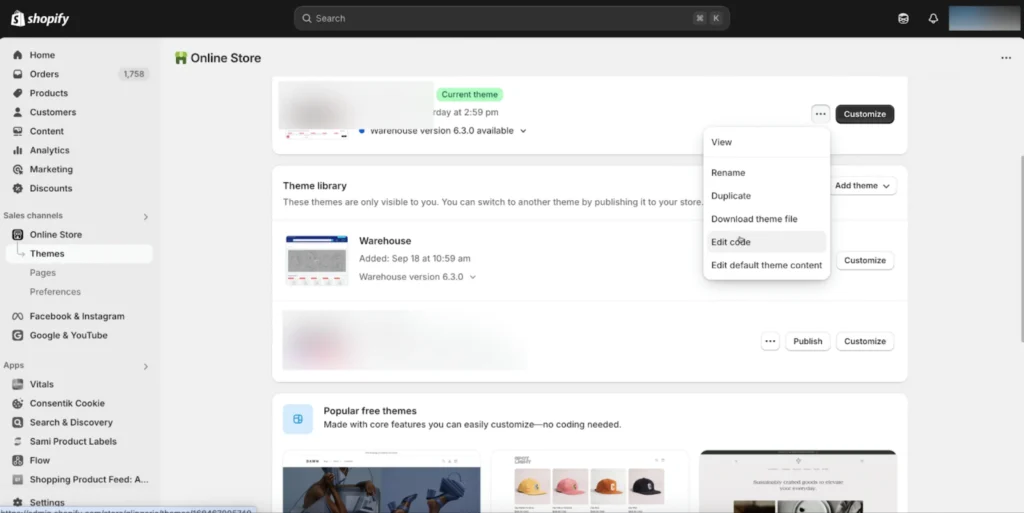
And then create a new snippet file called “website-schema.liquid” and paste our website schema code:
https://github.com/mehmetsanli/schema-markup/blob/main/website-schema-markup
Finally, you just need to render your website schema code in your theme.liquid file like corporation schema markup.
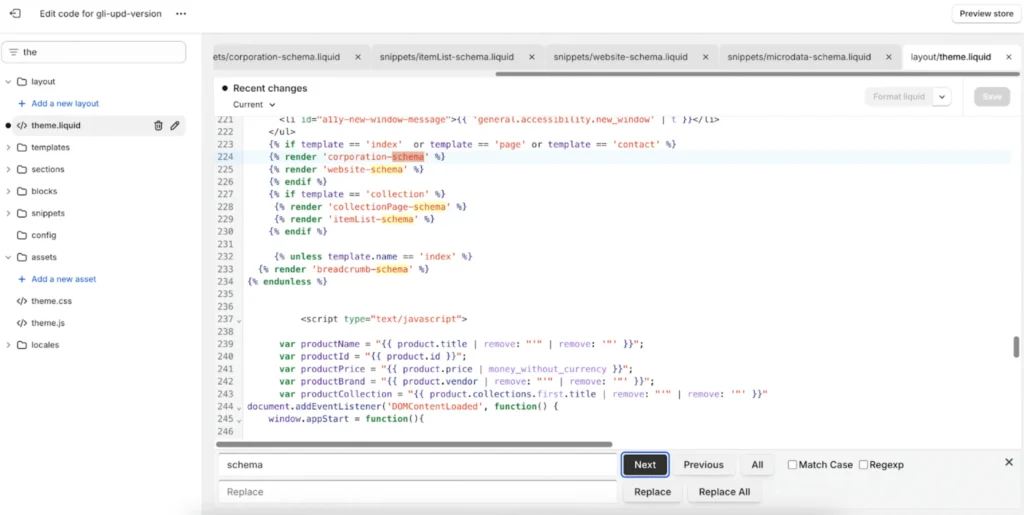
#3. CollectionPage & ItemList Schema Markup:
CollectionPage and itemList schema markups are really helpful to boost your product collection/category pages on Shopify. These markups tell Googlebot what this collection is about and what it offers.

First, you need to create a new snippet called “collectionPage-itemList-schema.liquid” and then paste the code below:
<script type="application/ld+json">
{
"@context" : "http://schema.org",
"@type": "CollectionPage",
"name": "{{ collection.title }}",
"url": "{{ collection.url }}",
"description": "{{ page_description | escape }}"
}
</script>
{% if collection.products.size > 0 %}
<script type="application/ld+json">
{
"@context": "http://schema.org",
"@type": "ItemList",
"url": "{{ collection.url }}",
"name": "{{ collection.title }}",
"description": "{{ page_description | escape }}",
"numberOfItems":"{{ collection.all_products_count }}",
"itemListElement": [
{% for product in collection.products %}
{
"@type": "ListItem",
"position": {{ forloop.index }},
"url": "{{ product.url }}",
"name": "{{ product.title | escape }}"
}{% unless forloop.last %},{% endunless %}
{% endfor %}
]
}
</script>
{% endif %}Finally, you just need to render your collectionPage and itemList schema markups on your theme.liquid file. Please be careful to run them on just collection pages with this code:
{% if template == 'collection' %}
{% render 'collectionPage-schema' %}
{% render 'itemList-schema' %}
{% endif %} 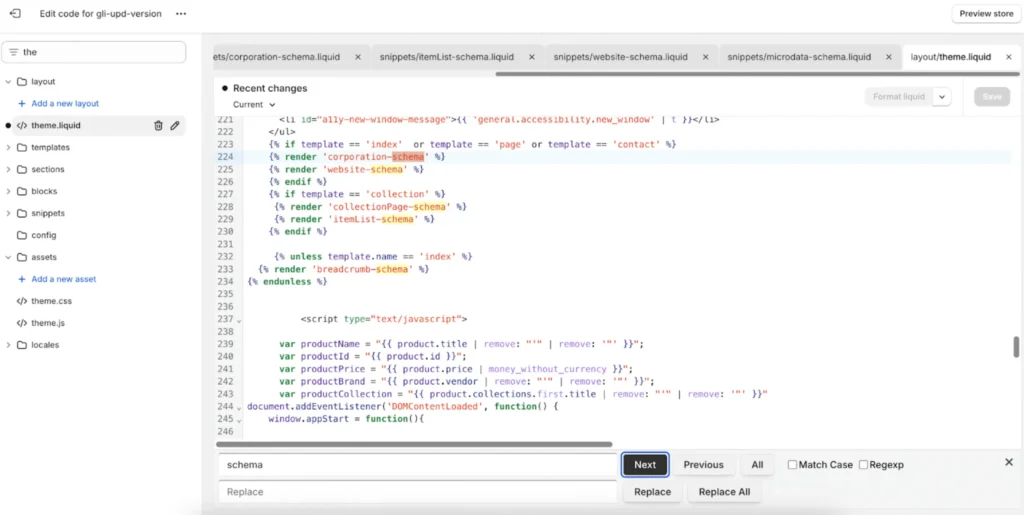
Types of Structured Data for Your E-commerce Website
Implementing various schema types can enhance different aspects of your store:
- Organization/Corporation: Provides information about your business, such as name, logo, and contact details.
- Website: Defines your site’s search functionality.
- Local Business: Details about your physical store locations, including address and opening hours.
- Product: Information about individual products, including name, description, price, and availability.
- Breadcrumb: Displays the page’s position within the site hierarchy.
- ItemList: Represents a list of items, such as a collection of products.
- CollectionPage: Information about product collections or categories.
Each schema type serves a specific purpose and contributes to a comprehensive structured data strategy.
Other Schema Types to Consider
Beyond the basics, consider implementing additional schemas:
- Review: Showcases customer reviews and ratings.
- FAQ: Displays frequently asked questions and answers.
- Article: For blog posts and news articles, providing details like author and publication date.
- Video: Information about video content, including duration and thumbnail.
These schemas can further enhance your site’s visibility and user engagement.
E-commerce Schema FAQ
Q: How can e-commerce schema impact my online store’s visibility?
A: Implementing schema markup can lead to rich snippets in search results, making your listings more attractive and informative, which can increase click-through rates and drive more traffic to your store.
Q: What is schema in e-commerce?
A: Schema in e-commerce refers to structured data markup that provides search engines with detailed information about your products, business, and content, enhancing how your site appears in search results.
Q: Does Shopify use schema?
A: Yes, many Shopify themes include basic schema markup by default. However, to fully leverage structured data, you may need to add or customize schema manually or use apps for comprehensive coverage.
Wanna see how your website perform?
Let's run a comprehensive technical SEO audit for your website and share a compelling SEO strategy to grow your online business.
SEO Audit →


